 Finally! Finally LowePro is making backpacks that carry cameras, not camera bags that happen to be carried on your back. Not only that, the Rover Pro is a versatile bag when you aren’t carrying your camera with ample room for a long day hike. I have used this bag on a couple of short trips and a 6 mile slog through a wet and tangle arroyo and am here to report and the good and the bad.
Finally! Finally LowePro is making backpacks that carry cameras, not camera bags that happen to be carried on your back. Not only that, the Rover Pro is a versatile bag when you aren’t carrying your camera with ample room for a long day hike. I have used this bag on a couple of short trips and a 6 mile slog through a wet and tangle arroyo and am here to report and the good and the bad.
Specifications
Capacity:
- Pro DSLR with attached 24-70mm lens
- 1 extra lens or flash
- Tripod or monopod
- 2 liter hydration reservoir
- Sleeping pad, small tent, ice axe/trekking poles, and other personal items
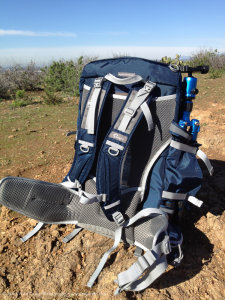 Size(Interior):
Size(Interior):
5.7W X 6.2D X 12.4H in./
14.5 X 15.8 X 31.5 cm
Size(Exterior):
12.6W X 10.6D X 19.7H in./
32 X 27 X 50 cm
Weight:
5.07lbs/2.3kg
Features
The concept of the Rover Pro AW is a backpack first and a camera bag second. This works well for active photographers, but there are some snags.
First, the bag is actually two bags. The first is the main backpack body. It comes complete with full suspension system, water bladder/bottle pocket, tripod straps/sleeve, compression straps, and a couple of pockets in the back and top for odds and ends. It also has two loops for ice axes (yes, I might actually use them as such) or trekking poles.
 The rear pocket is perfect sized for a guide book or iPad/tablet and the water bottle/bladder pocket comes with compression straps and a covered outlet to you’re your bladder hose. These days, that is just about required. There are small pockets on the hip belt and they will hold a memory card wallet or smart phone (my iPhone 4 fits with extra room). Although, with a phone in the hip pocket and my hands in my pants pockets, it wasn’t comfortable as the hip-belt pockets got in the way, but only with a phone in them. If you never hike with your hands in your pockets, no worries.
The rear pocket is perfect sized for a guide book or iPad/tablet and the water bottle/bladder pocket comes with compression straps and a covered outlet to you’re your bladder hose. These days, that is just about required. There are small pockets on the hip belt and they will hold a memory card wallet or smart phone (my iPhone 4 fits with extra room). Although, with a phone in the hip pocket and my hands in my pants pockets, it wasn’t comfortable as the hip-belt pockets got in the way, but only with a phone in them. If you never hike with your hands in your pockets, no worries.
The suspension system is good and I was happy the waist belt reached my hips unlike many packs. I am 6’1” and often need a slightly longer pack so the weight rests on my hips and not my shoulders. This is hard to find in camera bags but the Rover Pro 35L was very comfortable in this sense. Calling it a waist belt would be wrong, I guess, it is more of a proper hip belt as that is where the weight should rest.
Inside the main compartment is a removable camera bag. It is not big, but can hold a full size DSLR with battery grip and long lens. In my case, I was able to hold a Canon 7D, grip and 28-300mm L lens. There is a slot section in the bag for memory, hard drive, flash or what not. The 45L version of this bag comes with another internal bag for a long lens. This internal bag also has elastic pouches on the outside and two zippered pockets on the inside for filters, gels, memory cards, etc… Lastly, it has a top loop and side carry handles as it can be used by itself outside the bag.
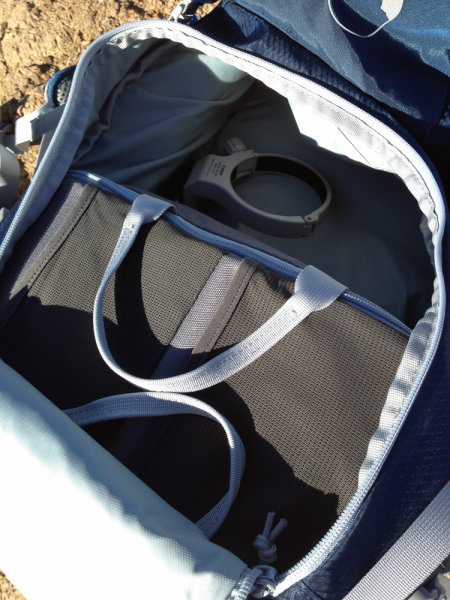
Oh, and as this is the AW (All Weather) version, it comes with a rain cover.
In Real Life
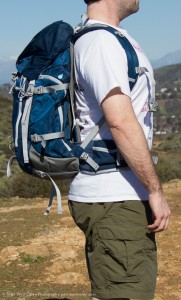 One important thing to realize about this bag, is it is not intended to be a fast action bag. It is meant to carry a lot over a long distance comfortably. Truth be told, you might be better served with your regular overnight backpack and put your camera in an insert. What this bag helps with that your overnight pack might not, is access. While it is not intended for quick access to a camera like most camera bags with their integrated organization, it does allow for either top or back panel access. From here, the camera insert bag is removed and away you go.
One important thing to realize about this bag, is it is not intended to be a fast action bag. It is meant to carry a lot over a long distance comfortably. Truth be told, you might be better served with your regular overnight backpack and put your camera in an insert. What this bag helps with that your overnight pack might not, is access. While it is not intended for quick access to a camera like most camera bags with their integrated organization, it does allow for either top or back panel access. From here, the camera insert bag is removed and away you go.
I would rate the 35L version as a great day trip pack and the 45L as an overnight bag, possibly. Not for winter use, but I can see how a sleeping bag, pad, and small tent can fit in an on this bag (straps on the bottom help with gear haulage). When accessing the camera insert, I often found items would shift and it would take a few extra steps to put the insert back in the main bag after shooting. This make sense and is a fair trade off for not having wasted space as you would with a integrated bag.

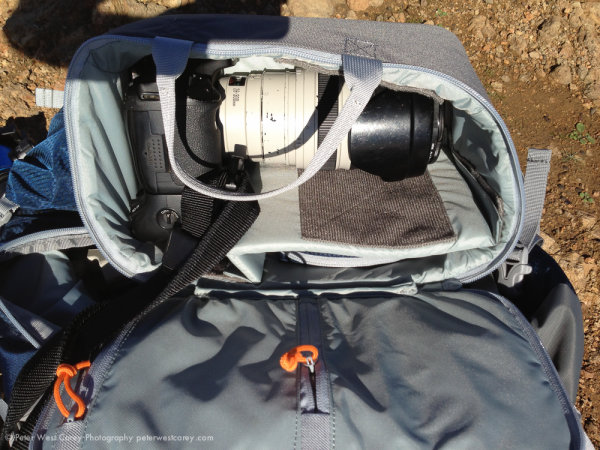
I thought the hip belt adjustment was lackluster. I could tighten it easily enough with the extra long pulls (good for those with a larger belly) but loosening the straps was unduly difficult and took two hands to sort of ‘jog’ the strap back. Not a deal breaker, but it can use improvement. It took me a couple of tries to figure out how to adjust the shoulder straps for my height (hint: push against the velcro hard) and I was very happy that it adjusted to my length. The metal stays and semi-rigid frame is of quality design and the ‘trmpoline’ backing did keep the pack away from my back and cool.
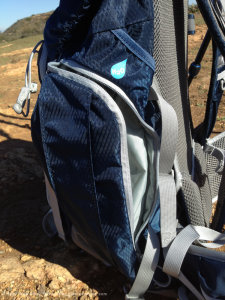 The zippers are average, nothing to rave about and they work. The rain cover, oh the rain cover…the rain cover finally DETACHES!! Thank you, LowePro! There is a pocket for it on the bottom of the bag and it doesn’t interfere with the bottom sleeping pad straps, which is nice. A strip of velcro helps keep the cover with the bag if you like, but once wet, the cover can be detached to dry. It also has a couple of compression straps on the top to form fit. Nice touch. I have not long term tested the cover, though.
The zippers are average, nothing to rave about and they work. The rain cover, oh the rain cover…the rain cover finally DETACHES!! Thank you, LowePro! There is a pocket for it on the bottom of the bag and it doesn’t interfere with the bottom sleeping pad straps, which is nice. A strip of velcro helps keep the cover with the bag if you like, but once wet, the cover can be detached to dry. It also has a couple of compression straps on the top to form fit. Nice touch. I have not long term tested the cover, though.
Conclusion
When I realize how this bag is to be used, to get stuff to the shoot after a long hike over varied terrain, I appreciated it more. The camera bag is not of the quality of the f-stop bags, such as the Satori EXP, but the price is also less. While not set up for quick access, the pack does well to keep gear comfortable on my back over longer distances. The rain cover and tripod straps work well and I like that they didn’t try to make this a computer carrier too. The 35L has a lot of space and the 45L would be even larger.
Adjustable shoulder straps help this bag fit a range of torso sizes and the straps for gear are not excessive just for looks like some bags. What’s more, take the camera bag insert out and the pack functions as a very useful ‘regular’ 35L backpack for an overnight hike. I would recommend this bag for some someone wanting a more comfortable pack, but it also competes with standard, traditional day packs which can fit a right-sized camera insert. It’s not the only bag in this niche, but it does its job very well.
Post originally from: Digital Photography Tips.
Check out our more Photography Tips at Photography Tips for Beginners, Portrait Photography Tips and Wedding Photography Tips.
LowePro Rover Pro 35L AW Camera Backpack [Review]

Digital Photography School



































 Finally! Finally LowePro is making backpacks that carry cameras, not camera bags that happen to be carried on your back. Not only that, the Rover Pro is a versatile bag when you aren’t carrying your camera with ample room for a long day hike. I have used this bag on a couple of short trips and a 6 mile slog through a wet and tangle arroyo and am here to report and the good and the bad.
Finally! Finally LowePro is making backpacks that carry cameras, not camera bags that happen to be carried on your back. Not only that, the Rover Pro is a versatile bag when you aren’t carrying your camera with ample room for a long day hike. I have used this bag on a couple of short trips and a 6 mile slog through a wet and tangle arroyo and am here to report and the good and the bad. Size(Interior):
Size(Interior): The rear pocket is perfect sized for a guide book or iPad/tablet and the water bottle/bladder pocket comes with compression straps and a covered outlet to you’re your bladder hose. These days, that is just about required. There are small pockets on the hip belt and they will hold a memory card wallet or smart phone (my iPhone 4 fits with extra room). Although, with a phone in the hip pocket and my hands in my pants pockets, it wasn’t comfortable as the hip-belt pockets got in the way, but only with a phone in them. If you never hike with your hands in your pockets, no worries.
The rear pocket is perfect sized for a guide book or iPad/tablet and the water bottle/bladder pocket comes with compression straps and a covered outlet to you’re your bladder hose. These days, that is just about required. There are small pockets on the hip belt and they will hold a memory card wallet or smart phone (my iPhone 4 fits with extra room). Although, with a phone in the hip pocket and my hands in my pants pockets, it wasn’t comfortable as the hip-belt pockets got in the way, but only with a phone in them. If you never hike with your hands in your pockets, no worries.
 One important thing to realize about this bag, is it is not intended to be a fast action bag. It is meant to carry a lot over a long distance comfortably. Truth be told, you might be better served with your regular overnight backpack and put your camera in an insert. What this bag helps with that your overnight pack might not, is access. While it is not intended for quick access to a camera like most camera bags with their integrated organization, it does allow for either top or back panel access. From here, the camera insert bag is removed and away you go.
One important thing to realize about this bag, is it is not intended to be a fast action bag. It is meant to carry a lot over a long distance comfortably. Truth be told, you might be better served with your regular overnight backpack and put your camera in an insert. What this bag helps with that your overnight pack might not, is access. While it is not intended for quick access to a camera like most camera bags with their integrated organization, it does allow for either top or back panel access. From here, the camera insert bag is removed and away you go.

 The zippers are average, nothing to rave about and they work. The rain cover, oh the rain cover…the rain cover finally DETACHES!! Thank you, LowePro! There is a pocket for it on the bottom of the bag and it doesn’t interfere with the bottom sleeping pad straps, which is nice. A strip of velcro helps keep the cover with the bag if you like, but once wet, the cover can be detached to dry. It also has a couple of compression straps on the top to form fit. Nice touch. I have not long term tested the cover, though.
The zippers are average, nothing to rave about and they work. The rain cover, oh the rain cover…the rain cover finally DETACHES!! Thank you, LowePro! There is a pocket for it on the bottom of the bag and it doesn’t interfere with the bottom sleeping pad straps, which is nice. A strip of velcro helps keep the cover with the bag if you like, but once wet, the cover can be detached to dry. It also has a couple of compression straps on the top to form fit. Nice touch. I have not long term tested the cover, though.
You must be logged in to post a comment.